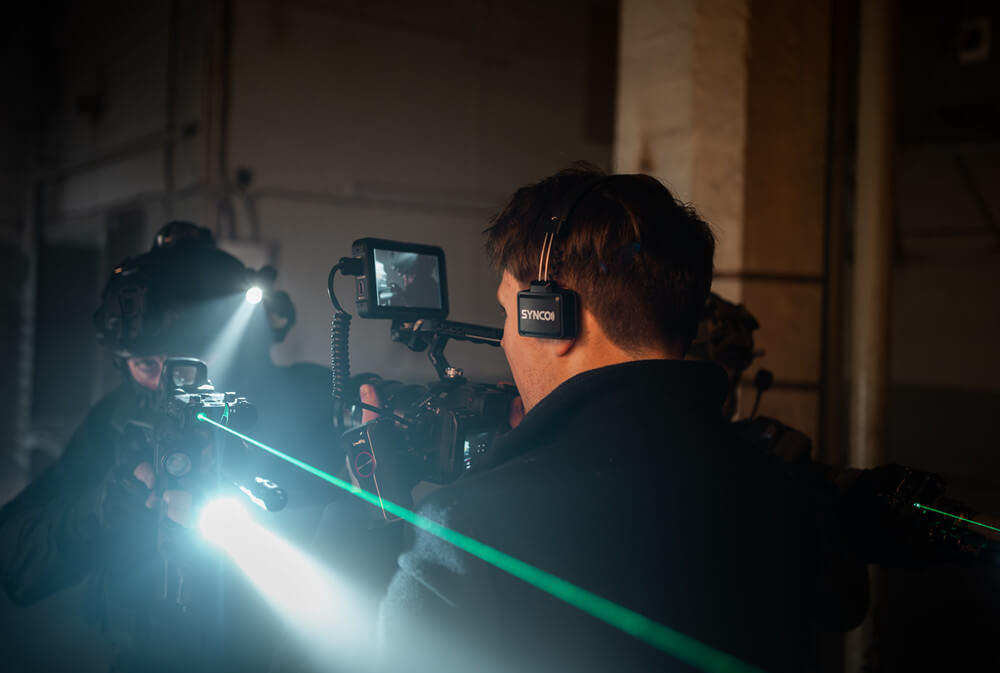In the world of production, seamless communication is paramount. Wireless production intercom has emerged as a crucial tool, offering flexibility, mobility, and efficiency on set. Let's delve into their features, pros & cons, and considerations to help you choose the best option for your needs.

What is wireless intercom for production and its counterparts?
Production intercom stands as a cornerstone in any production setup, facilitating seamless communication among team members. Many different systems are available on the market today, spanning different price ranges, and catering to diverse requirements. If you are looking for a system for video production, click this article Guide to Intercom System for Video Production to explore what it is and how to choose.
In broad strokes, production intercom systems fall into three main categories: Hard Wired, Wireless, and WiFi/LTE-based systems. Let's delve into the advantages and disadvantages of each category for a better understanding.
Hard wired
Hard-wired intercom systems, the original form of communication, come in two main types: balanced and unbalanced. Both have stood the test of time and function effectively. However, it's crucial to note that these systems are not compatible with each other.
For essential production tasks, opting for a reliable hard-wired system is recommended. These systems boast robustness and are less susceptible to malfunctions compared to their counterparts. They operate without the need for batteries and minimize the risk of interference. Additionally, they are often the most economical choice for production intercom setups.
Traditionally, hard-wired intercoms utilized simple twisted pairs, ensuring easy installation and minimal maintenance. Nowadays, many systems transmit digital signals through Cat5 or fiber cables.
- Pros: Affordable, reliable, no battery reliance, sturdy, clear transmission
- Cons: Limited mobility, necessitates physical wiring
Wireless production intercom system
As technology advances, wireless production intercom comes to the market. These systems typically offer high reliability, although their range may be limited at times or necessitate repeater antennas. Many wireless setups function optimally in line-of-sight environments.
Wireless intercoms provide unparalleled flexibility, granting technicians unrestricted movement within the stage or production area, free from tangling messes of wire. Moreover, these systems often support full-duplex communication and can interface with hard-wired setups, providing a versatile communication environment.
However, wireless intercoms are susceptible to interference, as they operate on radio frequencies. This poses a risk of losing communication with the team. While efforts are made to mitigate such risks, they remain present. Additionally, wireless intercoms rely on batteries for operation, introducing another potential point of failure and increasing operational costs.
It's crucial to ensure that the chosen system complies with legal regulations and to conduct thorough research to future-proof against potential frequency changes by regulatory bodies like the FCC.
- Pros: Exceptional mobility, full-duplex communication, free from wiring
- Cons: Battery dependency, potential battery failure leading to communication issues, radio interference, range limitations
WiFi/LTE based intercom systems
Recently introduced to the market are numerous WiFi and LTE-based intercom systems. These setups leverage a computer to host audio transmissions, with users simply downloading an app on their smartphones to connect. Typically, these systems offer compatibility with conventional wired or wireless setups through a digital interface.
These solutions prove highly cost-effective and provide significant value for many houses of worship seeking non-critical production communication. Their reliability is on par with the strength of your WiFi or LTE connection.
Some of these systems still exhibit slight latency due to the WiFi/LTE network path, so they may not be the optimal choice for critical cue calling. However, they excel in general communication scenarios.
- Pros: Cost-effective, scalable, simple installation, readily accessible
- Cons: Latency may pose challenges, reliability tied to WiFi or LTE strength, potential signal drops on certain phones, influenced by cell phone battery levels

How to choose wireless intercom for video production, filmmaking, live events, and more?
Take into account the following factors when selecting a wireless intercom system for filmmaking and production:
Channels: A basic wireless intercom system for filmmaking may have everyone linked to the same channel. However, many systems provide several channels, allowing various groups to readily interact with one another. For instance, during a theater performance, the stage manager should communicate separately with the sound and lighting crews.
Interoperability: Not every intercom brand facilitates interoperability with other brands or models. However, with further investigation, you can identify products that seamlessly integrate with other wireless intercom systems. For example, the SYNCO Xtalk X5 can be paired with the Xtalk X3.
Headsets: Opt for headset intercom system designed for extended wear. It's advisable to select well-cushioned headsets that fully enclose the ear, providing isolation from surrounding noise.
User Capacity: Choose wireless intercom systems with a high user capacity. For example, SYNCO models facilitate communication among 18 individuals at most.
Battery Performance: Prioritize battery longevity. An ideal system should offer a runtime of at least 6 to 10 hours and swift charging capabilities.
Sound Quality: Seek a system that ensures clear audio quality, minimizing interference and background noise for effective communication.
Coverage Range: Select a wireless intercom system capable of transmitting audio over long distances to accommodate multiple users. A minimum range of 1000ft is recommended.
What wireless production intercom to use: SYNCO Xtalk lineup is recommended
The SYNCO Xtalk is a superb wireless, full-duplex wireless intercom headset that functions within the 2.4GHz band, the first intercom system using this frequency. Unlike other wireless production intercoms, the Xtalk allows you to set any headset as the master headset. This avoids the hassles of a lost or run-out-of-power master.
It stands out as a top choice for professionals in filmmaking and recording, boasting an impressive 1100ft range. It excels in scenarios such as live events and multi-camera setups, facilitating seamless communication among camera operators, directors, producers, and sound recordists. Not only does the Xtalk feature a sleek, modern design, but it also prioritizes comfort with lightweight construction and soft foam padding on its single-ear headphones. The system runs on a battery, and you can enjoy a 24-hour runtime for the whole system.
Features and specs
- Select-able master headset
- 2.4GHz frequency for legal use around the world
- Dominant mode for muting all remotes
- 350m (1100ft) range
- High-quality Acoustic Echo Cancellation (AEC)
- 150Hz – 7kHz frequency response
- Rechargeable and replaceable batteries
- 3.5mm port for audio monitoring
- Rotatory mic auto mute
- 188g weight (battery Included)
- 18 maximum users
